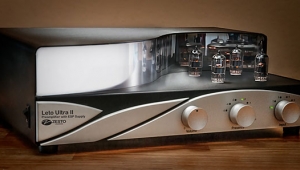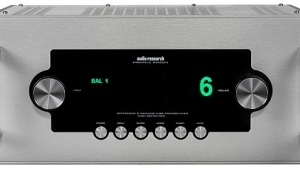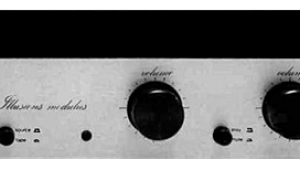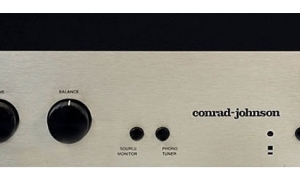| Columns Retired Columns & Blogs |
Nagra PL-P preamplifier Page 3
Layout & ergonomics
The main rotary switch selects Off, Phono, and three line-level inputs marked A through C. There's a red stripe behind the Off position to remind the user when the power is on; it's all very Euro. The phono stage powers down during line-level operation, and the PL-P auto-mutes when switching between sources. There's a further 15-second delay when selecting Phono. When the PL-P is switched off, no power is supplied to the audio stages, but the rechargeable power-cell management system remains active. During the test period I left the PL-P's line-stage powered up, as recommended by the importer. As the DC-DC converters effectively decouple the tubes and active circuits from the batteries and external power supply, there seemed little to gain by running the unit on its power cells alone.
The main rotary switch selects Off, Phono, and three line-level inputs marked A through C. There's a red stripe behind the Off position to remind the user when the power is on; it's all very Euro. The phono stage powers down during line-level operation, and the PL-P auto-mutes when switching between sources. There's a further 15-second delay when selecting Phono. When the PL-P is switched off, no power is supplied to the audio stages, but the rechargeable power-cell management system remains active. During the test period I left the PL-P's line-stage powered up, as recommended by the importer. As the DC-DC converters effectively decouple the tubes and active circuits from the batteries and external power supply, there seemed little to gain by running the unit on its power cells alone.
Next to the main rotary switch are a pair of Input Level potentiometers. Using the modulometer, one can fine-tune the signal/noise ratio of the input, and adjust for the overload characteristics of the amplifier on the output. The Input Level potentiometers can be ganged, or decoupled and adjusted independently with a small gear-driven clutch located just below the controls. This is also, effectively, the balance control.
The modulometer, which monitors input levels, is made at the factory and is said to have carefully controlled ballistics. It sports two "coaxial" pointers: black for the left channel, red for the right. The face of the "instrument," as Nagra prefers to call it, is graduated with three scales. The uppermost is a logarithmic scale in relative dB from -20 to +3dB, referenced to the output at the tape loop. Under that are linear-scale markings in absolute voltage from 0 to 1.4V, corresponding to the scale above referenced to 1V at the tape-loop connectors. The third scale has linear-scale markings in absolute voltage that show battery reserve per cell from 0.9V to 1.5V.
Manual: "A written legend printed on the lower center portion of the dial reminds the user that all modulometer markings are referenced to 0dB=1V on the tape-loop connectors." And don't you forget it. "The modulometer measures the peak value of the signal irrespective of the form or level, and takes into consideration the strongest positive or negative value. It is equipped with a memory, so that with very brief signals, the pointer advances and stays for a sufficient time in order for a reading to be taken."
Or, as Steve Lee explained it, "Certain amps clip at 150mV, others at a full 6V. So, using the modulometer and the input potentiometers, you can fine-tune the sound for the best S/N ratio. And the modulometer is indispensable when using the tape loop to record, especially in digital, where as soon as you touch 0dB, you're finished." The "instrument" can be lit with two internal LEDs. At night, with the modulometer glowing, you'll marvel at the PL-P's fusion of retro-chic and new-millennium modernism.
Recordists will be happy to find a pair of trim pots on the tape loop that, used in conjunction with the modulometer, balance the levels between source and tape output. I didn't use the modulometer in this way, but it was handy for optimizing analog and digital inputs. Typically, I reduced the input gain a few dB for digital and raised it for analog, thus compensating for the differing input voltages. You can actually do this for each recording in either medium, so, depending on your level of devotion to best sound, knock yourself out. I know I did.
It was fascinating to see that the Symphonic Line RG-8 cartridge, when set perfectly for azimuth (lowest crosstalk), read unequal output between left and right channels. (Correct azimuth cants the cartridge over quite drastically, in fact, meaning that the cartridge's motor is not orthogonal with its body.) In contrast, the Clearaudio Insider was almost spot-on; best azimuth and equal output are at the same point. I'd like to have seen the Japanese-made generator in the Wilson Benesch Analog (to be reviewed next month) on the modulometer. Mirroring a similarly precise culture, azimuth was spot-on with the cartridge just a nudge from straight up as seen from the front. In fact, its fulsome sound would have mated well with the Nagra, but the importer needed it back for demos, alas.
The modulometer's spiffy Swiss countenance is flanked by a Source/Tape toggle on the left, and another switch for checking the batteries and lighting up the meter. Next to that is another toggle labeled Line/Mute/Phones. The right side-panel houses two sets of in-phase Line Outs, and the tape loop. (All connections on the PL-P are single-ended.) The left side-panel has four sets of stereo input RCAs: three line-level, one phono. There's also what Nagra calls a "technical ground post" for eliminating those pesky ground loops that lead to hum in the phono stage.
The toggles are small, with a sexy feel to their action—the snap is followed by a fast damping characteristic. But I was surprised by the output gain potentiometer's undistinguished feel and action. Same with the input potentiometers—another pair of tiny pots with a rather pedestrian feel to their action. I was also surprised by the relatively thin aluminum used everywhere except in the faceplate and top. You can see that Nagra is going about things their own way. Steve Lee explained to me that parts are always chosen for sound quality and reliability.
- Log in or register to post comments




































